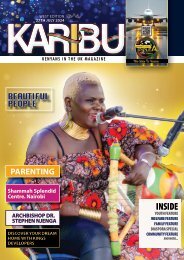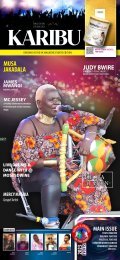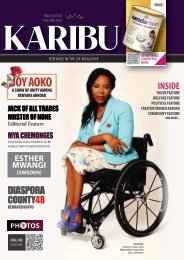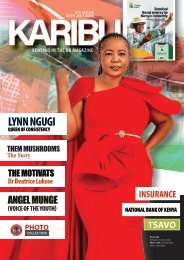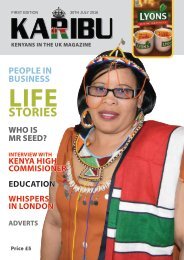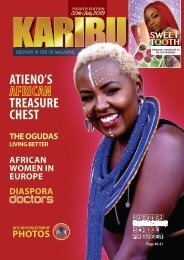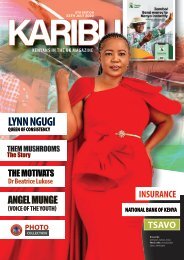Create successful ePaper yourself
Turn your PDF publications into a flip-book with our unique Google optimized e-Paper software.
The role of ethnicity in Kenyan politics.<br />
By Thomas Musau<br />
Kenya goes to the polls on August 8. As<br />
in previous elections, the role played<br />
by ethnicity and tribalism are likely<br />
to decide the election. Experts say<br />
politicians beat the drums while their<br />
tribesmen and women dance to the<br />
tune.<br />
Kenyan politics have been characterized<br />
by ethnic tensions since independence<br />
in 1963. But it was not until 2008 that<br />
the demons of tribalism finally flared up<br />
after the hotly disputed elections which<br />
left over a thousand people dead and<br />
thousands displaced.<br />
The clashes mainly between the larger<br />
ethnic tribes, the Kikuyus, Luos and<br />
Kalenjins, erupted after Mwai Kibaki<br />
from the Kikuyu community was<br />
declared the winner amidst accusations<br />
of rigging and electoral manipulation.<br />
Ethnicity parse has never been the<br />
problem. The problem arises when<br />
politicians use ethnicity for their<br />
personal gain, and create a divide<br />
which fuels an appeal and loyalty to the<br />
tribe- often over country. Historically<br />
in the traditional societies, the issue<br />
of belonging to a tribe was not a big<br />
issue until and during the fight for<br />
independence.<br />
Tribalism in Kenya dates back to the<br />
colonial era. From 1920 to 1963, Kenya<br />
was under the rule of the British who<br />
used the divide and rule tactic to<br />
govern. For years they played one side<br />
off against another, in particular the<br />
Kikuyus and Luos whom they considered<br />
a threat owing to their numerical<br />
superiorities.<br />
The first two political parties before<br />
and during independence Kenya - the<br />
Kenya Africa National Union (KANU) and<br />
the Kenyan African Democratic Union<br />
(KADU) set off the current tribal politics<br />
in the country. KANU was a Kikuyu and<br />
Luo alliance party; while KADU was<br />
comprised of other small tribes who<br />
feared the domination by KANU. KADU<br />
was founded by Daniel Arap Moi, a<br />
Kalenjin from Rift valley and others.<br />
President Jomo Kenyatta (father of the<br />
incumbent president Uhuru Kenyatta)<br />
was accused of sidelining the Luos, in<br />
particular Jaramongi Odinga (father of<br />
current opposition leader Raila Odinga)<br />
in favour of Moi, who succeeded him in<br />
1978 as the second president of Kenya.<br />
During his time in office until 2002,<br />
Moi was accused of entrenching and<br />
perpetuating tribalism and the politics A second commission, the National<br />
of divide and rule. His presidency was Cohesion and Integration Commission,<br />
also marked by deadly tribal animosities. is still working on ending the enduring<br />
The major outbreak was in 1992 with divisions between Kenyans. In its view,<br />
the Molo clashes in the vast Rift valley the solution is to address economic<br />
region which left 5,000 people dead and equality and opportunities for all,<br />
another 75,000 displaced. The conflict regardless of tribal affiliations.<br />
was primarily between the Kalenjin<br />
It’s well documented that the<br />
and the Kikuyu communities with land appointments in government,<br />
ownership cited as one of the key<br />
parastatals and other government<br />
reasons behind the tragic conflict.<br />
bodies reflect a deliberate effort to<br />
Though regional conflict among tribes favour certain ethnic lines-depending<br />
was still in existence, it was not until on who is in power. Since independence,<br />
the advent of multi-party politics in<br />
leaders often fill the civil service and<br />
1992 that it really became evident- and state-owned institutions with members<br />
ultimately flared up into violence and of their ethnic group, and those from<br />
death.<br />
ethnic communities viewed as being<br />
Major parties were already divided<br />
supportive of the ruling regime.<br />
along tribal lines. For example, the<br />
The cabinets of presidents Jomo<br />
Forum for the Restoration of Democracy Kenyatta, Daniel Moi, and Mwai Kibaki<br />
(FORD-Kenya) was associated with the all had a disproportionate number of<br />
Luhya tribe, the Democratic Party with members from their respective tribes.<br />
the Kikuyu, the Labour Democratic Party Tribalism is to blame for many of the ills<br />
with the Luo, while the Kalenjin tribe in our country today such as corruption,<br />
largely supported KANU. Today, voting ethnic clashes and underdevelopment.<br />
in Kenya whether parliamentary, civic To end this people must be given jobs<br />
or presidential, is done almost entirely based purely on merit- their skills<br />
along tribal lines.<br />
and training, not tribal lineage. Many<br />
In the political sphere, leaders appeal political observers are now warning<br />
to people of their own tribes when<br />
that Kenya is on the wrong track in<br />
they want support. They also use their the run-up to the 2017 elections.<br />
tribes as leverage when they bargain for Political alliances based on tribes<br />
positions and favours from government. have dominated Kenya’s politics since<br />
The ‘big five’ tribes have influenced who independence. As in the past, political<br />
is elected, owing to their numerical<br />
alliances have been made along ethnic<br />
advantage. According to Kenya’s<br />
lines. The Jubilee alliance of President<br />
National Bureau of Statistics, the largest Uhuru Kenyatta and his deputy William<br />
ethnic groups are the Kikuyu, the Luhya, Ruto is overwhelmingly backed by the<br />
the Kalenjin, the Luo and the Kamba. At Kikuyus and the Kalenjins.<br />
present, the majority of Luos support The opposition National Alliance (NASA)<br />
opposition leader Raila Odinga, the<br />
is no different. It is a union of tribes led<br />
Kambas are behind Kalonzo Musyoka. by Raila Odinga (a Luo from Nyanza),<br />
The Kalenjins back Deputy President Moses Wetangula and Moses Mudavadi<br />
William Ruto, while the Kikuyus support (Both Luhyas from western Kenya) and<br />
President Uhuru Kenyatta.<br />
Kalonzo Musyoka from the Kamba tribe<br />
The political elite are known to play<br />
of eastern Kenya.<br />
the ethnic divide game to get elected Mass registration drive rallies have<br />
as they know that elections are never been ethnically politicized. Politicians<br />
based on issues, ideologies or principles. returning to their backyard for campaign<br />
Attempts to slay the dragon of tribalism rallies have no clear agendas other than<br />
in Kenya have not borne much fruit.<br />
playing the usual tribal cards.<br />
Commissions have been formed, songs The tribal card is being played behind<br />
composed, and wars fought. The Truth, the scenes. It’s not being amplified<br />
Justice and Reconciliation Commission as such but politicians are harping on<br />
was formed in 2008 after the 2007<br />
tribal arithmetic to gain control and<br />
post-election violence. The commission get political mileage-and ultimately be<br />
concluded that ethnic conflicts mainly elected. Such is the tragedy of our tribal<br />
stem from land inequality and regional politics.<br />
3RD EDITION | JULY 2018<br />
imbalances in wealth distribution.<br />
77




